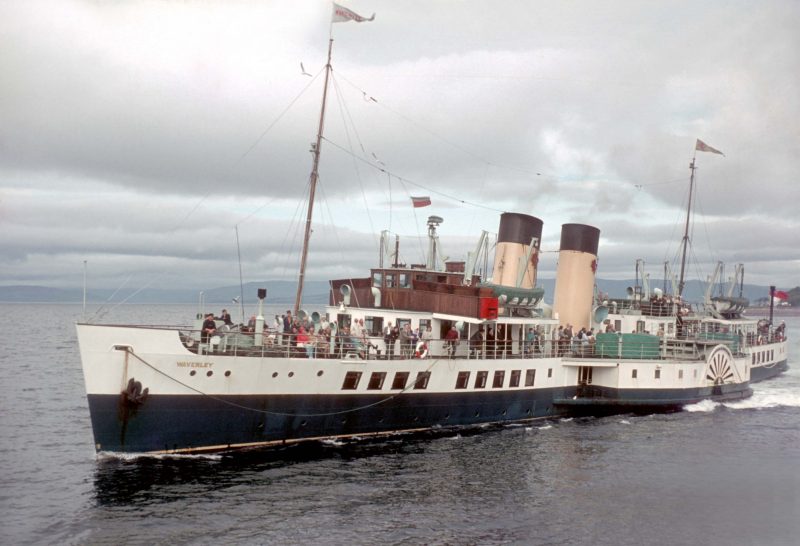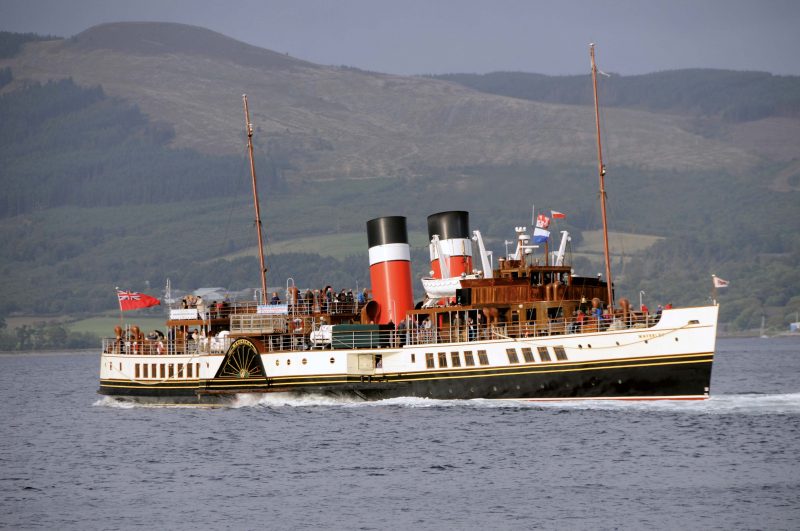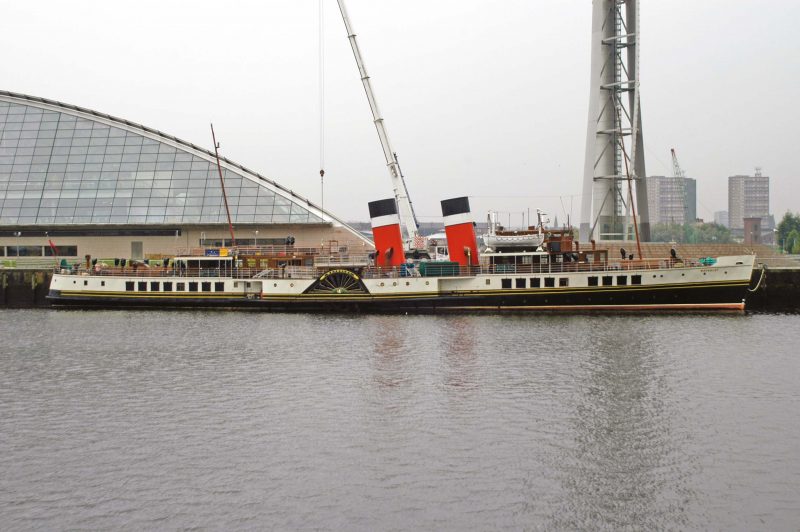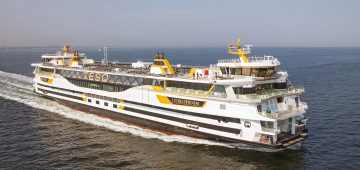
 Completed and delivered seventy years ago on 5th June, PS Waverley was the last paddle steamer to be built on the Clyde. Since 1970 she has also been the world’s sole remaining sea-going paddle steamer.
Completed and delivered seventy years ago on 5th June, PS Waverley was the last paddle steamer to be built on the Clyde. Since 1970 she has also been the world’s sole remaining sea-going paddle steamer.
The 693 gt ship was built by A. & J. Inglis at their Pointhouse shipyard, which stood at the confluence of the rivers Clyde and Kelvin, close to the site of the existing Riverside Museum. She was named after Sir Walter Scott’s 1814 novel and was the second paddle steamer to bear the name. The first, built in 1899, was sunk during the evacuation of Dunkirk in 1940 with the loss of most of the ship‘s crew and many of the 600 troops they had just rescued.
For her first year of service PS Waverley was part of the London and North Eastern Railway (LNER) fleet which, like all railway company-owned fleets, provided a commuter service ferrying passengers from outlying villages to their nearest station. PS Waverley made her maiden voyage on 16th June 1947 and regularly carried passengers from Craigendoran Pier, on the northern shore of the Firth of Clyde, to Arrochar at the head of Loch Long.
At the end of her first season she was berthed for the winter in Bowling Harbour, on the Forth and Clyde Canal. By the start of her second season in 1948 the railways had been nationalised, and the LNER was taken over by the British Transport Commission (BTC). Its fleet was merged with those of the Caledonian Steam Packet Company (CSP), which operated as a subsidiary of the BTC and had its headquarters at Gourock, 28 miles west of Glasgow.
Up to this point Waverley’s funnels had been painted in the LNER colours, black top, white stripe and red base, but now her funnels were repainted in the CSP colours of black and pale yellow.

For the next 25 years, Waverley continued to operate in and around the Firth of Clyde, providing passenger ferry services and day excursions to the Scottish lochs and occasionally covering for other vessels when they were temporarily out of service. During the 1950s she began cruising to the Isle of Arran, the largest island in the Firth of Clyde, as well as carrying passengers to Glasgow from some of the resorts on Scotland’s west coast.
In 1965 Waverley’s appearance changed again when her hull was painted in monastral blue, and the red Rampant Lion of Scotland added to each side of both funnels.
The 1950s were a boom time for the Clyde ferry services, but the 1960s saw a sharp decline as the cheap package holiday revolution took hold and millions of Brits deserted domestic seaside resorts in favour of sunnier climes abroad. The advent of car ferries was another major factor, and they gradually replaced the passenger-only ferries in the Clyde. One by one, the older ships were withdrawn from service and the smaller piers began to close, many to fall into disrepair.
In 1970, Waverley officially became the last sea-going paddle steamer in the world, and by the following year was one of only two large passenger ferries still operational in the Clyde.
Another major change in Waverley’s history came in 1973 when the Caledonian Steam Packet Company merged with the West Highlands ferry company David MacBrayne Ltd. to become Caledonian-MacBrayne (CalMac). The new company continued operating in the Clyde and around the Western Isles.
Rumours that Waverley might be scrapped after this merger seemed to be unfounded when she was given yet another makeover, this time having her funnels painted entirely in red with yellow circles added around the lions. Yet, after completing the 1973 season, CalMac announced that she had been withdrawn from service due to spiralling operating costs.
A New Lease Of Life
On 8th August 1974, CalMac sold Waverley to the Paddle Steamer Preservation Society (PSPS) for the token payment of £1, on condition that the ship would not operate in competition with the company’s last remaining cruiser, TS Queen Mary.
The PSPS had been established in 1959 to save the last of Britain’s paddle steamers from the scrapyard and to restore them to sailing condition. By the time the society acquired the Waverley, restoration work had already started on its first purchase, PS Kingswear Castle, a coal-fired paddle steamer that had previously operated on the River Dart in Devon.
The PSPS launched a fundraising appeal to save the Waverley in the autumn of 1974, and in less than a year the society was able to relaunch the Waverley on the Clyde, fully restored and with her original colour scheme of black, white and red reinstated. A new charity, the Waverley Steam Navigation Company, was set up to operate the vessel.
On 28th April 1977 PS Waverley left Scottish waters for the first time for a trial excursion from Liverpool to Llandudno. This was deemed such a success that it was agreed to extend her sailings to other parts of the UK the following summer.

First, though, there was a major setback in July 1977 when the ship was returning to Gourock after a cruise along Scotland’s west coast. Approaching Dunoon Pier in the Firth of Clyde, the Waverley’s steering failed and she ran aground on The Gantocks, a notoriously treacherous cluster of rocks that had claimed several victims despite the presence of an illuminated beacon since the late 19th century.

Held fast in the rocks by her head, the Waverley suffered such extensive damage that it looked as though she would be heading for the scrapyard. However, she was rescued and repaired, although CalMac lost heavily financially as the ship was out of service for six weeks.
The following year Waverley was once again involved in major excursions, this time spending a month sailing around the English south coast. This proved so successful that in 1981 she embarked on her first full season of cruising around different locations in the UK after being fitted with a new boiler. She continued to spend the summer months in her home waters in Scotland. Twenty five years on, she is still providing this extensive service, sailing around the Bristol Channel, the south coast of England, the Thames in London, Liverpool and Llandudno and the Firth of Clyde.
Restoration
In 1997 PS Waverley was awarded £2.7 million by the Heritage Lottery Fund to go towards a substantial rebuilding programme to restore the ship to her original form while complying with modern safety regulations. The contract was awarded to George Prior Engineering Ltd. in Great Yarmouth, Norfolk, and was undertaken in two stages.
The first stage started in February 2000, and included cleaning and replating the ship’s hull, replacing the sponsons, refurbishing and polishing the moving parts of the main engine, fitting new funnels, renewing some of the timber decking and carrying out major restoration work to the dining saloons, galley and passenger toilets. New boilers, weighing 20 tons each, were produced by Scottish boiler manufacturer Cochran & Co and transported to Great Yarmouth for fitting.
Lack of funding meant the job couldn’t be completed at this stage, but nevertheless when PS Waverley sailed back to Glasgow on August 16th 2000, the transformation was substantial.
On 17th May 2002, the Heritage Lottery Fund announced the release of further funding to enable the completion stage of the rebuild to go ahead. With additional funding from Glasgow City Council and the Paddle Steamer Preservation Society, all was set and on 14th October 2002 the Waverley duly returned to Great Yarmouth, where she remained for nearly eight months.
This time the work included a full refurbishment of the lifeboats, further replating of the hull, repainting of the bow, refurbishing of the forward bar and extensive safety checks. By the time Waverley was ready to sail back to Glasgow on 14th June 2003, she had been fully restored to her former glory at a total cost of £7 million.
Her return to the Clyde was marked by a weekend of special events with a ‘Back to the 40s‘ theme, the highlight of which was Waverley setting sail from Glasgow’s Anderston Quay on the Saturday morning to retrace the route of her maiden voyage in June 1947.
A press release issued on 10th June 2003 by Douglas McGowan, the man who had made that historic £1 purchase from CalMac nearly 30 years earlier, confirmed that Waverley had been “restored and rebuilt in a style sympathetic to the 1940s, with shipyard skills of yesteryear, such as riveting the steel plates and laying traditional wooden decks. During the last eight months, Waverley has been given new passenger lounges on both the promenade and main decks, new wooden masts and refurbished Officers and Crew accommodation. The main engine and paddle wheels have been completely stripped, overhauled and rebuilt and a new sewage plant has been installed. In addition, over 3 miles of new wooden decks have been laid.”
McGowan added, “This unique restoration project will guarantee Waverley’s future for the benefit and education of future generations. In 1947, Waverley was one of several paddle steamers still sailing on the Clyde. Now, she is the very last survivor and a very special lady.”

Waverley Today
During the winter months PS Waverley is moored at Pacific Quay on the Clyde. She continues to sail every year from May to October, providing passenger excursions around the Firth of Clyde and the Western Isles in the high summer months, Liverpool and Llandudno during August, the Bristol Channel and the south coast in September and the Thames in London from September to October. She is operated by Waverley Excursions Ltd., and current timetables and other information can be found on the company’s website.
Sailing charges cover operating costs, but the ship continues to depend on donations for maintenance work. In 2011 a national appeal was launched when the Waverley was in need of urgent major repairs. She was saved largely by a substantial donation from Euromillions lottery winners.
In 2015, the Paddle Steamer Preservation Society launched a Ruby Anniversary Appeal to mark the 40th anniversary of Waverley’s 1975 voyage, her first in the care of the PSPS, and to raise funds for essential repairs. In January this year the society announced that the fund has so far raised £33,700, enabling some of those essential repairs to go ahead. This includes replacing the mainmast and renewing decayed deck timbers.
Since 2003 Waverley has been listed in the National Register of Historic Ships as “a vessel of pre-eminent national importance”. In 2011 she was awarded the Institution of Mechanical Engineers 65th Engineering Heritage Award, and in the same year featured in the Sherlock Holmes film A Game of Shadows, starring Robert Downey Jr, Jude Law and Stephen Fry. She has also been awarded four stars by Visit Scotland, and Waverley Excursions estimates that to date she has carried over five million passengers from sixty ports around the UK.
Waverley’s ongoing preservation and busy sailing schedule ensure the continuation of a tradition that goes back to the early 19th century, when Henry Bell launched the world’s first commercial paddle steamer, Comet. By the 1860s paddle steamer excursions were hugely popular. Today there are still a few other paddle steamers plying inland waters, such as PS Maid of the Loch on Loch Lomond and PS Kingswear Castle on the River Dart. But PS Waverley remains the only sea-going paddle steamer, and as such occupies a unique place in our maritime heritage.
PS Waverley Vital Statistics
| Built: | A. & J. Inglis, Glasgow |
| Yard Number: | 1330P |
| Launched: | 2nd October 1946 |
| Maiden voyage: | 16th June 1947 |
| IMO Number: | 5386954 |
| Class and type: | Coastal excursion paddle steamer |
| Tonnage: | 693 gross |
| Length: | 239.84ft (73.15m) |
| Beam: | 57.97ft (17.68m) |
| Depth: | 6.29ft (1.92m) |
| Propulsion: | Diagonal triple expansion steam engine built by Rankin & Blackmore Ltd., Greenock, Scotland, 1947 |
| Boiler: | Thermax, manufactured by Cochran & Co, Annan, 2000 |
| Speed: | 14 knots (26 km/h; 16 mph) |
| Capacity: | Up to 925 passengers |
| Crew: | Minimum 19 crew required by MCA |
National Historic Ships UK Registration |
|
| Recorded: | 2nd February 1996 |
| Certificate: | No:90 |
| Status: | National Historic Fleet |





Comments
Sorry, comments are closed for this item